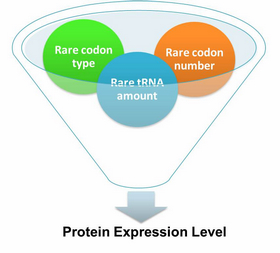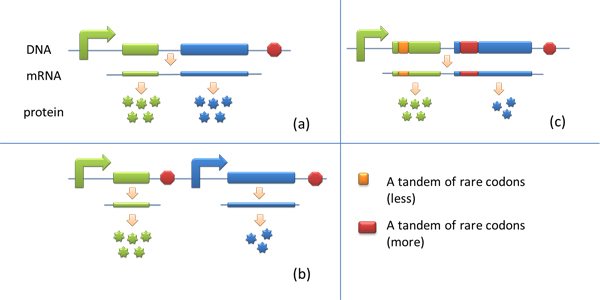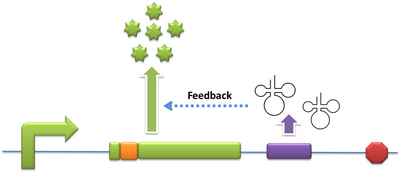Team:SJTU-BioX-Shanghai/Project/Application
From 2011.igem.org
ChobitParrot (Talk | contribs) (→II. Direct and Precise Regulation) |
ChobitParrot (Talk | contribs) (→II. Direct and Precise Regulation) |
||
| Line 38: | Line 38: | ||
[[image:11SJTU_App_02.jpg|center|application model]] | [[image:11SJTU_App_02.jpg|center|application model]] | ||
| + | |||
| + | We inserted the tDNAArg and luciferase gene into T7 operon so that both genes can be transcribed. tRNAArg can be correctly processed and become matured. Luciferase mRNA will be further translated into protein. The induced tRNAArg can facilitate the translation of luciferase-4AGG, achieving positive feedback. | ||
Another factor that influences protein biosynthesis may be the relative amount of two proteins. Our device can serve as a linker to regulate the relative amount of Protein A and Protein B. Rare codons are put into Gene A and Gene B. When rare tRNA is produced, it can influence the amount of both Protein A and Protein B, along with rare codon types and numbers. | Another factor that influences protein biosynthesis may be the relative amount of two proteins. Our device can serve as a linker to regulate the relative amount of Protein A and Protein B. Rare codons are put into Gene A and Gene B. When rare tRNA is produced, it can influence the amount of both Protein A and Protein B, along with rare codon types and numbers. | ||
[[image:11SJTU_App_03.jpg|center|application model]] | [[image:11SJTU_App_03.jpg|center|application model]] | ||
Revision as of 20:13, 28 October 2011
|
|
Expansion of Regulating Tools for Synthetic BiologyI. Multi-Level RegulationOur device has expanded the regulating tools for synthetic biology. We control protein biosynthesis through rare codon types, rare codon numbers and rare tRNA amount. Different combinations of these three elements can bring different outcomes in protein expression levels. rare codon types: AGA, AGG, CGA, CUA… rare codon numbers: 1, 2,3, 4,5, 6,7, 8,9, 10… rare tRNA amount: controlled by different strengths of promoters or riboswitch. II. Direct and Precise RegulationAs a translational regulatory tool, our device achieves more precise tuning of protein expression when compared with transcriptional tools. The controlling elements we use in this device are codons and tRNAs, the major participants of translation process. Thus manipulating these elements exert direct effects on protein biosynthesis. Here we offer two potential models for how this device can be used in pathway construction.
Yet to achieve maximum production, each protein amount should be individually regulated. Traditionally we use different promoters to control different genes. (b) However with our device, genes can be put under one single promoter yet producing different amount of protein. (c)
We inserted the tDNAArg and luciferase gene into T7 operon so that both genes can be transcribed. tRNAArg can be correctly processed and become matured. Luciferase mRNA will be further translated into protein. The induced tRNAArg can facilitate the translation of luciferase-4AGG, achieving positive feedback. Another factor that influences protein biosynthesis may be the relative amount of two proteins. Our device can serve as a linker to regulate the relative amount of Protein A and Protein B. Rare codons are put into Gene A and Gene B. When rare tRNA is produced, it can influence the amount of both Protein A and Protein B, along with rare codon types and numbers. |
 "
"



